Recent Water Damage Posts
Preserving History: Special Considerations for Water Damage Restoration in Historical or Older Homes
2/22/2024 (Permalink)
Historical and older homes often pose unique challenges when it comes to water damage restoration and remediation. In this blog post, we will discuss the special considerations involved in restoring water damage in historic or older homes and effective strategies to ensure the preservation of their original features.
Researching the Home's History
Before starting any restoration work in a historic or older home, it is crucial to research and understand the home's history. This includes identifying original building materials, learning about changes made to the property over time, and understanding the home's architectural style. This research helps in creating an appropriate remediation plan that considers the historical significance of the property.
Special Care for Historic Building Materials
Historical or older homes often feature unique and fragile building materials that require special care during water damage restoration. Professionals avoid using harsh chemicals and abrasive cleaning methods that can cause damage. Water damage restoration specialists for historical homes prefer the use of gentle approaches that preserve original features.
Repairing and Replacing Plumbing Systems
Older plumbing systems need close attention during restoration. Professionals must carefully evaluate the system's age, materials used, and integrity. Partial or total replacement of plumbing systems is necessary when dealing with serious cases of water damage.
Working with Specialized Restoration Experts
Water damage restoration in historic or older homes requires a unique skill set and experience. Working with restoration experts with a unique capacity for handling these situations is necessary for effective results. Experts must understand the historical significance of the building material to avoid damage and capture its original beauty.
Considerations for Occupant Safety
In addition to preserving the home's original visual aspects, safety considerations for occupants are essential during water damage restoration. Professionals carefully evaluate hazards that can arise from water damage, such as electrical shock and exposure to harmful contaminants.
Water damage restoration in historical or older homes requires a specialized approach that incorporates a comprehensive understanding of the property. These properties often hold significant historical and architectural value, making it imperative to prioritize preservation efforts. Conducting the necessary research and working with specialized restoration experts ensure the preservation of the home's original features and safety for occupants.
From researching the home's history to working with specialized experts, every step of the restoration process must be executed with care and precision.
The Hidden Hero: How Proper Insulation Saves Your Home from Water Damage
10/17/2023 (Permalink)
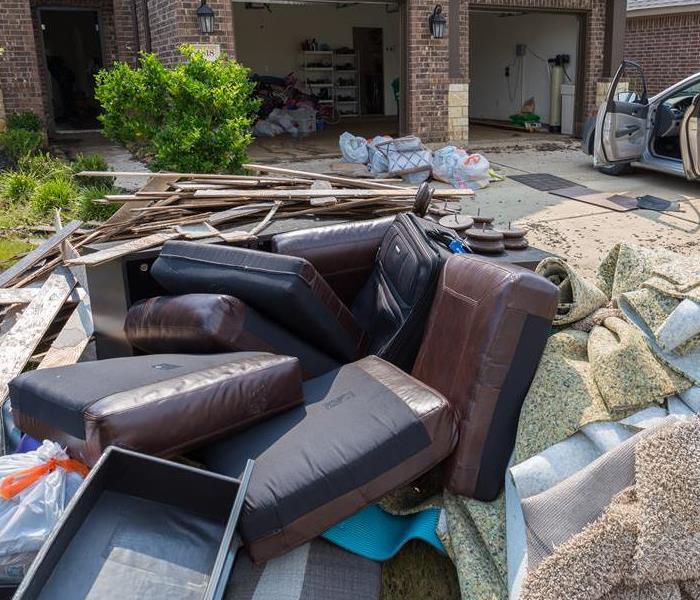 Protect your home with adequate insulation incase of water damage.
Protect your home with adequate insulation incase of water damage.
Water damage is a common and costly issue that many homeowners face. From burst pipes to leaky roofs, water intrusion can wreak havoc on a property, leading to structural damage and costly repairs. While addressing immediate leaks and implementing proper drainage systems are crucial steps in preventing water damage, one often overlooked element is the role of proper insulation. In this blog post, we will explore how proper insulation can play a significant role in preventing water damage and protecting your home.
Moisture Barrier
One of the important functions of insulation is to act as a moisture barrier. It helps prevent water vapor from entering the walls and ceilings, reducing the chances of condensation and subsequent mold growth. By maintaining a dry and insulated environment, the risk of water seepage and associated damage is significantly minimized.
Roof Protection
Adequate insulation in the attic plays a crucial role in preventing water damage caused by ice dams. During winter, warm air escaping from the home can cause snow on the roof to melt and then refreeze at the eaves, leading to ice dams. Proper insulation helps maintain a consistent temperature in the attic, preventing snow melt and reducing the likelihood of ice dams and subsequent roof leaks.
Pipe Protection
Insulation around pipes is essential in preventing frozen or burst pipes, which can result in significant water damage. Insulating pipes located in unheated areas, such as crawl spaces or basements, helps maintain a consistent temperature and prevents freezing. By ensuring proper insulation around pipes, you can significantly reduce the risk of water damage caused by pipe-related issues.
Siding Protection
Proper insulation also helps protect the exterior of your home from water damage. Insulated siding acts as a barrier against water intrusion, preventing rainwater from seeping into the walls and causing damage to the building materials. By preventing water intrusion, insulation helps maintain the integrity of the structure and reduces the risk of mold growth and wood rot.
Energy Efficiency
In addition to preventing water damage, proper insulation can also improve energy efficiency. Insulation helps regulate the temperature inside the home, reducing the need for excessive heating or cooling. This not only lowers energy bills but also helps prevent condensation and moisture buildup, reducing the potential for water damage caused by excessive humidity.
Professional Installation
While insulation plays a critical role in preventing water damage, it is essential to ensure proper installation by hiring professionals. Trained insulation contractors can assess your specific needs, recommend appropriate insulation materials, and install them correctly, ensuring optimal protection against water intrusion.
Investing in proper insulation is a proactive measure that can help safeguard your home from water damage. By acting as a moisture barrier, protecting the roof and pipes, preventing water intrusion into the walls, and improving energy efficiency, insulation plays a pivotal role in maintaining a dry and secure environment. Whether you are building a new home or considering retrofitting your existing property, consulting with insulation professionals is a prudent step to protect your home from the costly consequences of water damage.
6 Common Causes of Basement Floods and How to Prevent Them
7/25/2023 (Permalink)
Basement floods can be a homeowner's worst nightmare, causing extensive damage and requiring costly repairs. Understanding the common causes of basement floods is essential for homeowners to take proactive measures to prevent them. In this blog, we will explore the most frequent culprits behind basement floods and provide practical tips on how to safeguard your basement from water damage.
Heavy Rainfall and Poor Drainage
One of the primary causes of basement floods is heavy rainfall, especially when combined with poor drainage systems. When the ground becomes saturated with water, it can seep into your basement through cracks in the foundation or overwhelmed drainage systems. Regularly inspecting and maintaining your gutters, downspouts, and grading around your home can help redirect water away from your foundation.
Plumbing Issues and Burst Pipes
Leaky or burst pipes can wreak havoc on your basement, leading to sudden flooding. Aging or deteriorating plumbing systems, frozen pipes, or clogs can cause water to back up and flood your basement. Regular inspections, proper insulation, and timely repairs of plumbing issues can significantly reduce the risk of basement floods.
Sump Pump Failure
A malfunctioning or overwhelmed sump pump is another common cause of basement floods. Sump pumps are designed to remove excess water from your basement, but they can fail due to power outages, mechanical issues, or improper installation. Regularly testing your sump pump and ensuring it is in good working condition is vital for preventing basement floods.
Foundation Cracks and Leaks
Cracks in your foundation walls or floors can allow water to seep into your basement. Over time, these cracks can expand, leading to significant water intrusion during heavy rainfall or high water table levels. It's crucial to inspect your foundation regularly and seal any cracks or gaps promptly to prevent basement floods.
Improper Landscaping and Exterior Grading
Inadequate landscaping and improper grading around your home can contribute to basement floods. If the ground slopes towards your foundation instead of away from it, water can accumulate and find its way into your basement. Properly grading your landscape away from your foundation and installing proper drainage systems can help prevent basement floods.
Sewer Backup
Sewer backups can cause severe basement flooding and pose health risks due to contaminated water. Heavy rains or blockages in the sewer lines can result in sewer water backing up into your basement. Installing a backwater valve and regularly maintaining your sewer lines can help prevent sewer backups and basement floods.
Understanding the common causes of basement floods is the first step in safeguarding your home from water damage. By addressing issues such as poor drainage, plumbing problems, sump pump failures, foundation cracks, landscaping, and sewer backups, you can significantly reduce the risk of basement floods. Regular maintenance, inspections, and prompt repairs are key to protecting your basement and ensuring the safety and integrity of your home. Remember, if you do experience a basement flood, it's essential to seek professional help from disaster restoration experts, such as our SERVPRO of East Greenwich/Warwick team, to mitigate the damage and restore your basement to its pre-flood condition.
What are Flood Cuts?
11/9/2022 (Permalink)
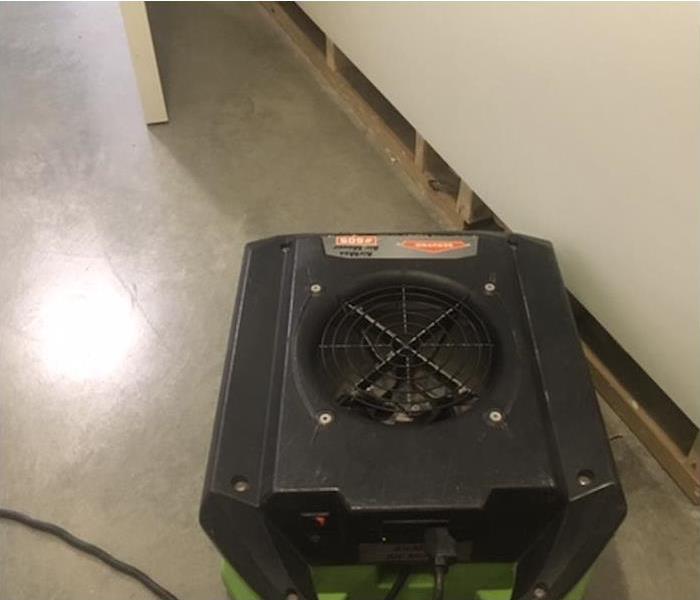 Flood cuts in East Greenwich property
Flood cuts in East Greenwich property
How Do Flood Cuts Work?
Flood cuts are an important part of the home restoration process after water damage. They remove wet drywall from the walls so that mold can't grow on the surfaces or in the insulation behind it. Flood cuts are also used to remove damaged sheetrock and plaster, which will need to be replaced anyway once molds have been cleared out. This guide will explain what flood cuts are, how they work, and why you should use them after a water loss has damaged your home or business.
Flood cuts are used to remove wet drywall
Flood cuts are a common technique for water damage. Flood cuts are used to remove drywall that is wet from water damage. The process involves cutting away the drywall, removing it and installing new drywall in its place.
Flood cuts remove only the damaged portions of your walls and ceiling, including anything that has been affected by water damage. This means you're saving as much of your home's original material as possible while also getting rid of affected materials before mold can begin to spread throughout your home.
Water damage can lead to mold growth, which requires professional remediation. Flood cuts remove excess water from the wall, preventing it from entering your home's structure while providing an ideal environment for mold growth.
Flood cuts are usually the best course of action for homeowners.
Flood cuts are usually the best course of action for homeowners, as they allow you to make the most out of your insurance money and save the most important parts of your walls. A skilled contractor can help you know how far to cut and which walls are necessary for flood cuts.
Removing drywall is the best course of action when it comes to preventing mold growth after a water loss. Mold remediation will require removing drywall anyway, so flood cuts are usually the best course of action for homeowners. It may seem like an inconvenience at first glance but taking precautions now will save time later when working with contractors after cleaning work has been completed.
While flood cuts are labor intensive, they are a great way to remove moisture and moisture affected materials from your home. Flood cuts also allow you to make sure that there isn’t any mold growing in your walls before it becomes an issue. Mold remediation will require removing drywall anyway, so flood cuts are usually the best course of action for homeowners to prevent mold growth from spreading throughout your home. If you think your home may have been affected by flooding or other water damage, then call our SERVPRO of East Greenwich/Warwick/Cranston team today! Our team can help you with everything from water and mold removal to rebuilding after storms and floods.
3 Signs That You Have a Water Leak
7/23/2022 (Permalink)
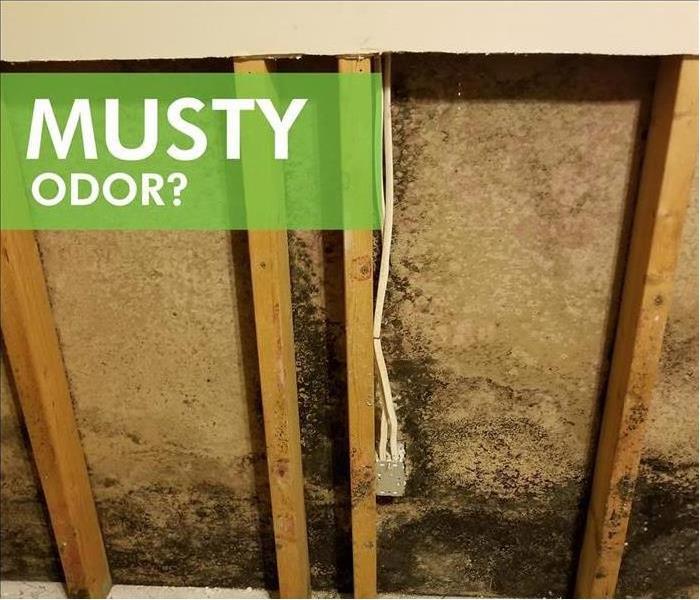 If you notice a musty smell in your building, you probably have mold growing.
If you notice a musty smell in your building, you probably have mold growing.
3 Signs That You Have a Water Leak
It's hard to pin down every single factor that affects the variable expenses in your commercial property in Apponaug, RI. It's normal for utility bills to fluctuate with usage. When you notice a big change, however, it is indicative of a specific problem. If you see any of these three signs, you probably have a water leak.
1. Large Utility Bill
A huge spike in your water bill means you are suddenly using a lot more water than you have before. A pipe break or leaking faucet can go undetected for weeks, especially if there are no visible signs. Even a small leak that hasn't done noticeable damage to walls, floors or ceiling tiles can cost a lot of money. The increase in your bill may be the first sign that anything is wrong.
2. Continually Running Meter
There are many reasons to keep an eye on your water meter. One of those reasons is that it can tell you if there is an unusual amount of water being used in your building. A meter that won't stop running even when there's no one in the building is a clear symptom of a water leak.
3. Musty Odor
A long-term leak leads to water damage. If left unchecked, it can also cause secondary damage such as mold growth. If you notice a musty smell in your building, you probably have mold growing somewhere, indicating the presence of water where it's not supposed to be. Water mitigation specialists can locate the problem and propose the best solution to deal with all the damage that the leak is causing.
A water leak isn't always obvious as soon as it happens. Sometimes, the first sign that you have a problem is an exorbitant water bill. If you notice this or any other sign of a leak, get it fixed as soon as possible to avoid other problems.
What is Category 1 Damage?
3/7/2022 (Permalink)
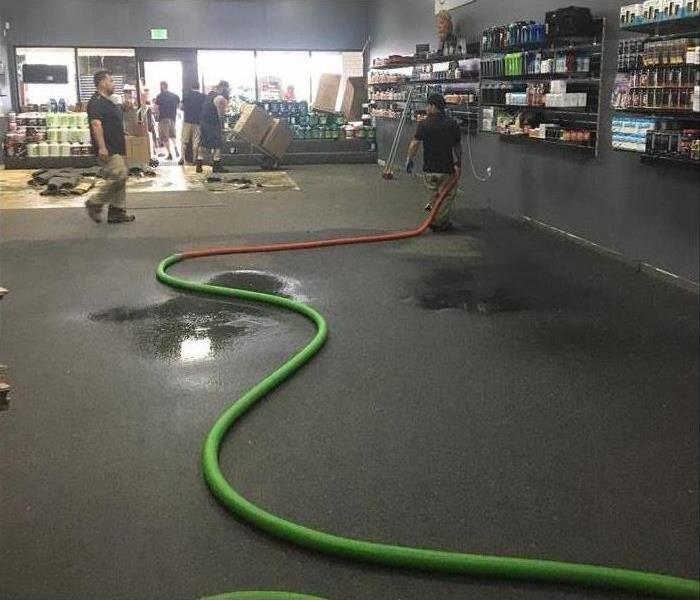 Commercial water loss in Kettle Corner, RI.
Commercial water loss in Kettle Corner, RI.
Three Categories of Water Damage
No one wants water damage in their building. If your commercial building in Kettle Corner, RI, is experiencing an issue with water damage such as a broken supply line or a burst pipe, it's important to understand the three categories of water damage. After figuring out what type of category your water damage is, you can begin the clean-up and restoration process.
Category one, or clean water, is the least severe type of water damage. It is considered the least severe because it does not contain any contaminants. Category two, or gray water, is mixed with chemicals or other contaminants. Category three, the most severe, is also known as black water. This type of water damage can contain bacteria and viruses.
Causes of Category One Damage
Category one can come from many sources. However, in order for it to be classified as category one, it must come from a sanitary source. Examples of sources of category one water are:
- A broken pipe
- An overflowing sink or malfunctioning appliance
- Melting snow or ice
Although clean water is the least severe category of water damage, it is still important to prevent lasting damages.
Clean-Up and Restoration From Category One Damage
The clean-up process for category one water damage is the easiest and quickest out of all the categories. Your first step should always be to contact a water restoration company to help you mitigate damages and restore your building. A restoration company will help by eliminating any standing water and removing any building materials or furniture that has been damaged. The company will likely also dry out your building and help get air circulating to speed up this process.
Category one water damage poses the least risk to your building, but it is still important to clean it up as quickly as possible. If you spot clean water damage, be sure to call in the professionals to help you get your building back to its original state.
Tips for Preventing Water Damage During Construction
2/22/2022 (Permalink)
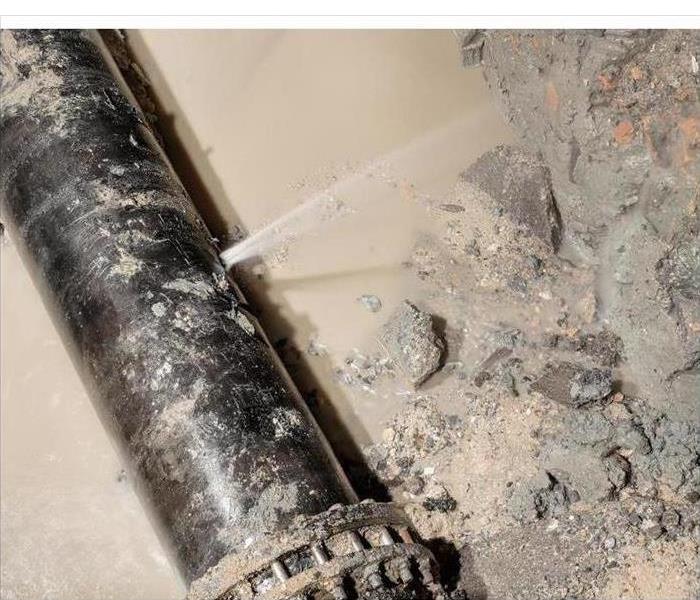 Something as simple as water pipe repair can delay a commercial building project in Cowesett, RI.
Something as simple as water pipe repair can delay a commercial building project in Cowesett, RI.
Tips for Preventing Water Damage During Construction
Water damage can be a threat to a building at any stage of its existence, and that includes during its construction. Something as simple as water pipe repair can delay a commercial building project in Cowesett, RI, indefinitely, depending on how much damage it causes. By following these tips, you can minimize the possibility of damages so that you can stay on schedule.
Have a Plan
The ability to foresee potential problems can be quite valuable. One broken pipe can result in several losses such as:
- Unsalvageable materials
- Labor to tear out and rebuild
- Project delays
Designing a solid quality control plan helps you order the steps of your project so that you can minimize the risk of water damage throughout the construction process. Your plan should include contact information for local water damage restoration specialists so that any problems you do encounter can be fixed quickly.
Have a Standard
A plan is only as good as the tools used to execute it. It makes sense not to skimp on the quality of your materials. Even the best materials, however, can be at risk if you don't have the same high expectations for the work being done. If you do need water pipe repair, make sure to hire certified professionals. Likewise, all subcontractors should be vetted for experience and expertise.
Have a Team
You need a group of people who are specifically tasked with making sure your quality control standards are met. There's no such thing as too much testing. Every step of the construction process should include a series of checks to make sure that your site and building are not in danger of getting flooded, and your quality control team can make sure these checks are consistent.
Every commercial construction project needs a plan and a means to execute it. Plan ahead so that you don't need water pipe repair, but have the contact information for trusted technicians if you do.
Water-Damage Cleanup and Care Tips for Your Home
2/13/2022 (Permalink)
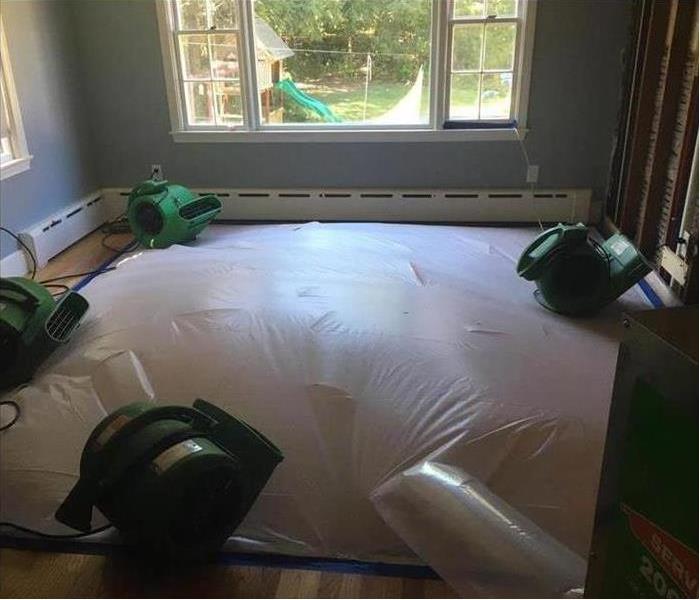 Taking care of your dry-cleaning needs after a broken pipe in a Kettle Corner, RI home.
Taking care of your dry-cleaning needs after a broken pipe in a Kettle Corner, RI home.
If you have recently experienced an emergency that left you with water in home living spaces, it’s important to understand how to take care of the damage while preserving your possessions and home furnishings. Proper care and cleanup is essential whenever you have a broken pipe or plumbing emergency because long-term secondary damage from these incidents can set in if the cleanup is not thorough and timely.
Steps To Take After the Emergency
When you have water coming into your house in Kettle Corner, RI, from plumbing problems and other residential mishaps, the first thing you need to do is stop the water and secure the area. Once that is done, you’ll need to make sure you know how to get the help you will need with the cleanup. Here are the steps you need to take to get that ball rolling.
- Contact your insurance company to make a claim
- Contact a professional water damage restoration service
- Keep the area secure and pets and people out until cleanup finishes
It’s common for insurance companies to work with certified damage-cleanup specialists to streamline payment, so you will want to get in touch with both organizations quickly.
Professional Dry Cleaning for Your Home Furnishings
Most homeowners’ policies cover water damage from plumbing emergencies and other residential causes. That means most homeowners will not see any cost above and beyond their deductible. For most people, that means there is a substantial cash savings to having professionals in Kettle Corner, RI, handle the cleanup. Damage from water in home living areas is expensive to clean up, as well as time-consuming.
Professionals also know how to remove water in home living spaces while repairing damage and preventing long-term issues from setting in because of the problem. They have the credentials and the experience to take care of your dry-cleaning needs after a broken pipe, so take advantage of that fact whenever you need help with cleanup.




 24/7 Emergency Service
24/7 Emergency Service





